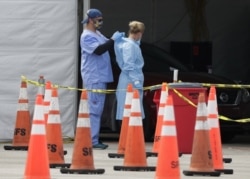The personal protective gear that was in dangerously limited supply during the early weeks of the coronavirus crisis in the United States is running low again.
This comes as the virus is quickly spreading in many states and hospitals are reporting more COVID-19 patients. Experts predict the crisis will worsen in the autumn.
A national labor organization representing medical workers is concerned about gear being reused. A group of doctors warned that their offices are closed because they cannot get face coverings and other supplies.
Democratic Party lawmakers are urging the administration of President Donald Trump to create a national plan to get and distribute gear.
Deborah Burger is president of National Nurses United. She reported findings of an opinion study of her group’s members. Those findings showed many nurses do not have the supplies they need, forcing them to re-use what they do have.
“We’re five months into this and there are still shortages of gowns, hair covers, shoe covers, masks, N95 masks,” Burger told reporters with The Associated Press, or AP.
Early in the pandemic, the situation was so difficult that nurses turned plastic waste bags into protective gowns. The lack of equipment forced states and hospitals to compete against each other, the federal government and other countries for supplies.
In general, supplies of protective gear are greater now. Many states and major hospital systems say they are better equipped. But medical professionals and some lawmakers have their doubts, as shortages begin to reappear.
The American Medical Association wrote to the Federal Emergency Management Agency, Vice President Mike Pence and members of Congress. The group called for a well-organized, national plan to buy and share gear across the country.
Democratic representative from New York Carolyn Maloney made an announcement last week ahead of a congressional committee hearing. Her announcement raised concerns about problems in the supply chain. Her report was based on talks with unnamed employees at medical supply companies. One of the employees warned that unprocessed material for gowns is not available at any cost in the amounts needed.
John Polowczyk is the U.S. military leader in charge of coronavirus-related supplies for the country. He told Congress last week that more than one-fourth of states have less than a 30-day supply.
“It would seem like in less than 30 days, we’re going to have a real crisis,” said Bill Foster, an Illinois Democratic representative.
The Federal Emergency Management Agency, or FEMA, controls the nation’s stockpile of protective equipment. The agency would not say which states have enough gear to last beyond 30 days and which do not. In June, the government started refilling its once-reduced stockpile with the goal of building up a two-month supply.
As of June 10, FEMA had distributed or directed private companies to distribute gear including 74 million N95 masks and 66 million pairs of hand coverings. The agency said it changed its distribution method to send more equipment to places that needed it most.
All U.S. states and territories have received some protective gear from FEMA. But an AP study of the agency’s own data found that the amounts varied widely when measured by population and the number of confirmed COVID-19 cases.
The AP study found that low-population, mostly rural states received the largest amounts of FEMA equipment per confirmed case. By the middle of June, for example, Montana had received 1,125 pieces of protective gear per case. That is far higher than the 32 pieces per case that the state of Massachusetts received.
I’m Pete Musto.
Geoff Mulvihill and Camille Fassett reported on this story for the Associated Press. Pete Musto adapted it for VOALearning English. Ashley Thompson was the editor.
_______________________________________________________________
Words in This Story
gear – n. supplies, tools, or clothes needed for a special purpose
distribute – v. to give or deliver something to people
gown(s) – n. a loose piece of clothing that covers most of the body
mask(s) – n. a covering for your face or for part of your face
pandemic – n. an occurrence in which a disease spreads very quickly and affects a large number of people over a wide area or throughout the world
intend(ed) – v. to want something that you control, provide, or have made to be used for a particular purpose or by a particular person
supply chain – n. the series of processes involved in the production and distribution of a given good or service
stockpile – n. a large supply of something that is kept for future use
varied – v. been different or became different
We want to hear from you. Write to us in the Comments Section.










